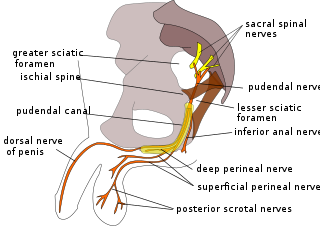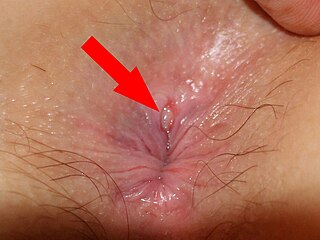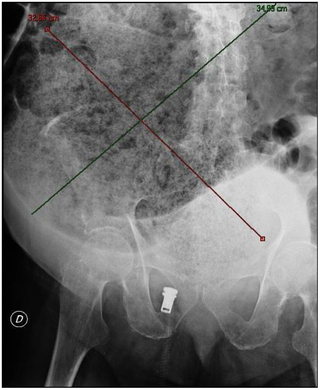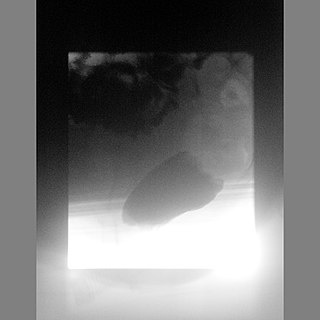Related Research Articles

The pudendal nerve is the main nerve of the perineum. It is a mixed nerve and also conveys sympathetic autonomic fibers. It carries sensation from the external genitalia of both sexes and the skin around the anus and perineum, as well as the motor supply to various pelvic muscles, including the male or female external urethral sphincter and the external anal sphincter.

Fecal incontinence (FI), or in some forms, encopresis, is a lack of control over defecation, leading to involuntary loss of bowel contents, both liquid stool elements and mucus, or solid feces. When this loss includes flatus (gas), it is referred to as anal incontinence. FI is a sign or a symptom, not a diagnosis. Incontinence can result from different causes and might occur with either constipation or diarrhea. Continence is maintained by several interrelated factors, including the anal sampling mechanism, and incontinence usually results from a deficiency of multiple mechanisms. The most common causes are thought to be immediate or delayed damage from childbirth, complications from prior anorectal surgery, altered bowel habits. An estimated 2.2% of community-dwelling adults are affected. However, reported prevalence figures vary. A prevalence of 8.39% among non-institutionalized U.S adults between 2005 and 2010 has been reported, and among institutionalized elders figures come close to 50%.

An anal fissure is a break or tear in the skin of the anal canal. Anal fissures may be noticed by bright red anal bleeding on toilet paper and undergarments, or sometimes in the toilet. If acute they are painful after defecation, but with chronic fissures, pain intensity often reduces and becomes cyclical.

A rectal prolapse occurs when walls of the rectum have prolapsed to such a degree that they protrude out of the anus and are visible outside the body. However, most researchers agree that there are 3 to 5 different types of rectal prolapse, depending on whether the prolapsed section is visible externally, and whether the full or only partial thickness of the rectal wall is involved.

Colorectal surgery is a field in medicine dealing with disorders of the rectum, anus, and colon. The field is also known as proctology, but this term is now used infrequently within medicine and is most often employed to identify practices relating to the anus and rectum in particular. The word proctology is derived from the Greek words πρωκτός proktos, meaning "anus" or "hindparts", and -λογία -logia, meaning "science" or "study".

Ileostomy is a stoma constructed by bringing the end or loop of small intestine out onto the surface of the skin, or the surgical procedure which creates this opening. Intestinal waste passes out of the ileostomy and is collected in an external ostomy system which is placed next to the opening. Ileostomies are usually sited above the groin on the right hand side of the abdomen.

A fecal impaction or an impacted bowel is a solid, immobile bulk of feces that can develop in the rectum as a result of chronic constipation. Fecal impaction is a common result of neurogenic bowel dysfunction and causes immense discomfort and pain. Its treatment includes laxatives, enemas, and pulsed irrigation evacuation (PIE) as well as digital removal. It is not a condition that resolves without direct treatment.

The internal anal sphincter, IAS, or sphincter ani internus is a ring of smooth muscle that surrounds about 2.5–4.0 cm of the anal canal. It is about 5 mm thick, and is formed by an aggregation of the smooth (involuntary) circular muscle fibers of the rectum. It terminates distally about 6 mm from the anal orifice.

An anal plug is a medical device that is often used to treat fecal incontinence, the accidental passing of bowel moments, by physically blocking involuntary loss of fecal material. Fecal material such as feces are solid remains of food that does not get digested in the small intestines; rather, it is broken down by bacteria in the large intestine. Anal plugs vary in design and composition, but they are typically single-use, intra-anal, disposable devices made out of soft materials to contain fecal material and prevent it from leaking out of the rectum. The idea of an anal insert for fecal incontinence was first evaluated in a study of 10 participants with three different designs of anal inserts.
Total mesorectal excision (TME) is a standard surgical technique for treatment of rectal cancer, first described in 1982 by Professor Bill Heald at the UK's Basingstoke District Hospital. It is a precise dissection of the mesorectal envelope comprising rectum containing the tumour together with all the surrounding fatty tissue and the sheet of tissue that contains lymph nodes and blood vessels. Dissection is along the avascular alveolar plane between the presacral and mesorectal fascia, described as holy plane. Dissection along this plane facilitates a straightforward dissection and preserves the sacral vessels and hypogastric nerves and is a sphincter-sparing resection and decreases permanent stoma rates. It is possible to rejoin the two ends of the colon; however, most patients require a temporary ileostomy pouch to bypass the colon, allowing it to heal with less risk of infection, perforation or leakage.

A sacral nerve stimulator is a small device usually implanted in the buttocks of people who have problems with bladder and/or bowel control. This device is implanted in the buttock and connected to the sacral nerve S3 by a wire. The device uses sacral nerve stimulation to stop urges to defecate and urinate by sending signals to the sacral nerve. The patient is able to control their bladder and/or bowel via an external device similar to a remote control.
Lateral internal sphincterotomy is an operation performed on the internal anal sphincter muscle for the treatment of chronic anal fissure. The internal anal sphincter is one of two muscles that comprise the anal sphincter which controls the passage of feces. The procedure helps by lowering the resting pressure of the internal anal sphincter, which improves blood supply to the fissure and allows faster healing. The procedure has been shown to be very effective, with 96% of fissures healing at a median of 3 weeks in one trial.
Sacral nerve stimulation, also termed sacral neuromodulation, is a type of medical electrical stimulation therapy.

Anismus or dyssynergic defecation is the failure of normal relaxation of pelvic floor muscles during attempted defecation. It can occur in both children and adults, and in both men and women. It can be caused by physical defects or it can occur for other reasons or unknown reasons. Anismus that has a behavioral cause could be viewed as having similarities with parcopresis, or psychogenic fecal retention.
Obstructed defecation syndrome is a major cause of functional constipation, of which it is considered a subtype. It is characterized by difficult and/or incomplete emptying of the rectum with or without an actual reduction in the number of bowel movements per week. Normal definitions of functional constipation include infrequent bowel movements and hard stools. In contrast, ODS may occur with frequent bowel movements and even with soft stools, and the colonic transit time may be normal, but delayed in the rectum and sigmoid colon.
Transanal irrigation of the rectum and colon is designed to assist the evacuation of feces from the bowel by introducing water into these compartments via the anus.

Neurogenic bowel dysfunction (NBD) is the inability to control defecation due to a deterioration of or injury to the nervous system, resulting in faecal incontinence or constipation. It is common in people with spinal cord injury (SCI), multiple sclerosis (MS) or spina bifida.
Low anterior resection syndrome is a complication of lower anterior resection, a type of surgery performed to remove the rectum, typically for rectal cancer. It is characterized by changes to bowel function that affect quality of life, and includes symptoms such as fecal incontinence, incomplete defecation or the sensation of incomplete defecation, changes in stool frequency or consistency, unpredictable bowel function, and painful defecation (dyschezia). Treatment options include symptom management, such as use of enemas, or surgical management, such as creation of a colostomy.
These procedures aim to inject bio-compatible material into the walls of the anal canal, in order to bulk out these tissues. This may bring the walls of the anal canal into tighter contact, raising the resting pressure, creating more of a barrier to the loss of stool, and thereby reducing fecal incontinence. This procedure has many advantages over more invasive surgery, since there are rarely any serious complications.
Implantable bulking agents are self-expanding solid prostheses which are implanted in the tissues around the anal canal. It is a surgical treatment for fecal incontinence and represents a newer evolution of the similar procedure which uses perianal injectable bulking agents.
References
- 1 2 3 Kaiser, Andreas M. "ASCRS core subjects: fecal incontinence". ASCRS. Archived from the original on 20 May 2013. Retrieved 29 October 2012.
- 1 2 Brown, SR; Wadhawan, H; Nelson, RL (Jul 2, 2013). "Surgery for faecal incontinence in adults". Cochrane Database of Systematic Reviews. 2013 (7): CD001757. doi:10.1002/14651858.CD001757.pub4. PMC 7061468 . PMID 23821339.
- 1 2 3 4 5 6 7 8 9 Zbar, Andrew P., ed. (2010). Coloproctology. Springer Specialist Surgery Series. Dordrecht Heidelberg: Springer. ISBN 978-1-84882-755-4.
- 1 2 3 4 5 6 Yamada, Tadataka; Alpers, David H., eds. (2009). Textbook of gastroenterology (5th ed.). Chichester, West Sussex ; Hoboken, NJ: Blackwell Pub. ISBN 978-1-4051-6911-0. OCLC 221961550.
- 1 2 3 4 5 6 7 8 9 10 11 12 Wolff, Bruce G.; American Society of Colon and Rectal Surgeons, eds. (2007). The ASCRS textbook of colon and rectal surgery. New York: Springer. ISBN 978-0-387-24846-2.
- ↑ Al-Bayati, I; Saadi, M; Elhanafi, S; McCallum, RW (November 2017). "Effectiveness of Bulking Agent (Solesta) Therapy in Fecal Incontinence in Patients Refractory to Conventional Therapies". The American Journal of the Medical Sciences. 354 (5): 476–479. doi:10.1016/j.amjms.2017.09.001. PMID 29173359.
- 1 2 3 4 Abe, T; Kunimoto, M; Hachiro, Y; Ohara, K; Inagaki, M (December 2022). "Injection of aluminum potassium sulfate and tannic acid in the treatment of fecal incontinence: a single-center observational study". Annals of Coloproctology. 38 (6): 403–408. doi:10.3393/ac.2021.00248.0035. PMC 9816560 . PMID 34284557.
- 1 2 3 4 5 6 Hong, KD; Kim, JS; Ji, WB; Um, JW (March 2017). "Midterm outcomes of injectable bulking agents for fecal incontinence: a systematic review and meta-analysis". Techniques in Coloproctology. 21 (3): 203–210. doi:10.1007/s10151-017-1593-0. PMID 28251356.
- 1 2 3 Maeda, Y; Laurberg, S; Norton, C (28 February 2013). "Perianal injectable bulking agents as treatment for faecal incontinence in adults". The Cochrane Database of Systematic Reviews (2): CD007959. doi:10.1002/14651858.CD007959.pub3. PMID 23450581.
- 1 2 3 4 Altomare, DF (November 2014). "Comments to "Perianal injectable bulking agents as treatment for faecal incontinence in adults"". Techniques in Coloproctology. 18 (11): 1139–1140. doi:10.1007/s10151-014-1218-9. PMID 25261078.
- 1 2 Vaizey, CJ; Kamm, MA (May 2005). "Injectable bulking agents for treating faecal incontinence". Br J Surg. 92 (5): 521–7. doi:10.1002/bjs.4997. PMID 15852421.
- ↑ de la Portilla, F (May 2014). "Internal anal sphincter augmentation and substitution". Gastroenterology Report. 2 (2): 106–11. doi:10.1093/gastro/gou004. PMC 4020126 . PMID 24759338.
- ↑ Mowatt, G; Glazener, C; Jarrett, M (2008). "Sacral nerve stimulation for fecal incontinence and constipation in adults: a short version Cochrane review". Neurourology and Urodynamics. 27 (3): 155–61. doi:10.1002/nau.20565. PMID 18314865. S2CID 25659802.
- ↑ Schrag HJ, Ruthmann O, Doll A, Goldschmidtböing F, Woias P, Hopt UT (2006). "Development of a novel, remote-controlled artificial bowel sphincter through microsystems technology". Artificial Organs. 30 (11): 855–62. doi:10.1111/j.1525-1594.2006.00312.x. PMID 17062108.
- 1 2 Ruthmann O, Fischer A, Hopt UT, Schrag HJ (2006). "[Dynamic graciloplasty vs artificial bowel sphincter in the management of severe fecal incontinence]". Der Chirurg (in German). 77 (10): 926–38. doi:10.1007/s00104-006-1217-0. PMID 16896900. S2CID 30246753.
- ↑ Belyaev O, Müller C, Uhl W (2006). "Neosphincter surgery for fecal incontinence: a critical and unbiased review of the relevant literature". Surg. Today. 36 (4): 295–303. doi:10.1007/s00595-005-3159-4. PMID 16554983. S2CID 34492125.
- ↑ Parisien, Christine J; Corman, Marvin L (1 February 2005). "The Secca Procedure for the Treatment of Fecal Incontinence: Definitive Therapy or Short-Term Solution". Clinics in Colon and Rectal Surgery. 18 (1): 42–45. doi:10.1055/s-2005-864080. PMC 2780133 . PMID 20011339.
- 1 2 Hull, Tracy (30 April 2007). "Fecal Incontinence". Clinics in Colon and Rectal Surgery. 20 (2): 118–124. doi:10.1055/s-2007-977490. PMC 2780180 . PMID 20011386.
- 1 2 Efron, JE (2004). "The SECCA procedure: a new therapy for treatment of fecal incontinence". Surgical Technology International. 13: 107–10. PMID 15744681.
- ↑ Margolin, DA (Spring 2008). "New options for the treatment of fecal incontinence". The Ochsner Journal. 8 (1): 18–24. PMC 3096428 . PMID 21603552.
- ↑ Nils G. Kock; Classic Article; foreword by Corman, Marvin L., M.D.; March 1994; Springer (web); Volume 37, Issue 3; excerpt from "Diseases of the Colon & Rectum"; Chapter: Intra-abdominal 'Reservoir' in Patients With Permanent Ileostomy; Pp. 278–279.